Book contents
- Frontmatter
- Table of Contents
- List of Plates and Figures
- 1 Introduction: Poetic License
- 2 Love, Beauty, and the Human Body as a Reflection of the Divine
- 3 Amorosa visione: Titian’s Allegory of Marriage and the Poetry of the Half-length Format
- 4 The Arms and Armour of Titian’s Allegory of Marriage
- 5 ‘Un disio sol d’eterna gloria e fama’: A Literary Approach to Titian’s Allegory
- 6 Psyche, Venus, Ceres and Their Friends: Titian’s Remixes
- 7 Art and the Double Meaning of Reflection in Titian’s Allegory of Marriage
- 8 Titian’s Allegory of Marriage as an ‘Allegory of Peace’
- 9 Vision and Touch in the Allegory of Marriage
- 10 Of Crystal Orbs and Divinatory Mirrors : The Vicissitudes of Pregnancy and Artistic Agency in Titian’s Allegory of Marriage
- Index
4 - The Arms and Armour of Titian’s Allegory of Marriage
Published online by Cambridge University Press: 16 November 2022
- Frontmatter
- Table of Contents
- List of Plates and Figures
- 1 Introduction: Poetic License
- 2 Love, Beauty, and the Human Body as a Reflection of the Divine
- 3 Amorosa visione: Titian’s Allegory of Marriage and the Poetry of the Half-length Format
- 4 The Arms and Armour of Titian’s Allegory of Marriage
- 5 ‘Un disio sol d’eterna gloria e fama’: A Literary Approach to Titian’s Allegory
- 6 Psyche, Venus, Ceres and Their Friends: Titian’s Remixes
- 7 Art and the Double Meaning of Reflection in Titian’s Allegory of Marriage
- 8 Titian’s Allegory of Marriage as an ‘Allegory of Peace’
- 9 Vision and Touch in the Allegory of Marriage
- 10 Of Crystal Orbs and Divinatory Mirrors : The Vicissitudes of Pregnancy and Artistic Agency in Titian’s Allegory of Marriage
- Index
Summary
Abstract
This chapter demonstrates that a technical study of the arms and armour depicted in paintings can be a useful tool in iconographic interpretation. The armour in Titian's paintings—especially those of two of his commissioners, Alfonso d’Avalos and Francesco Maria I della Rovere—can reveal how patrons wished to be understood in a military capacity. The armour presented can also be shown to reference Roman as well as medieval topoi. A secondary theme is an analysis of the allegorical role of the Cupid figure. It is not possible to affirm the identity of the sitter in the Allegory, but a close look at Titian's armoured portraits and the military metaphors may lead to a better understanding of the painting.
Key Words: Armour, infantry, war, weapons, arrows, Francesco Maria I della Rovere
Introduction
The identification of the armoured man in Titian's Allegory of Marriage as Alfonso d’Avalos is controversial (Plate 6 and Figure 4.1).
Alfonso III d’Avalos, Marquis of Vasto II and Marquis of Pescara VI (1502–1546), who was a commander in the army of Holy Roman Emperor Charles V, also collected art, wrote poetry and prose and commissioned paintings from Titian. The identification of Alfonso d’Avalos as the major male protagonist in the Allegory of Marriage was current by the seventeenth century. An examination of his military career and reputation may suggest the reason he has long been considered the subject of the painting. Whilst the identity of the armoured man in the Allegory is not easily affirmed, there is a second possible candidate in the person of another military general, Francesco Maria I della Rovere, Duke of Urbino.
This chapter focuses on analyses of the armour in Titian's portraits and how a man in armour would have been interpreted by a contemporary viewer. With even a few visible elements, a technical analysis of the armour in the Allegory of Marriage enables the reconstruction of the rest of the armour that is not shown or is obscured. It is important to be able to read the armour elements that are present and those that are clearly implied. A closer examination of the technical composition of the armour indicates whether a military battle armour is to be worn for foot combat or a cavalry charge.
- Type
- Chapter
- Information
- Titian's Allegory of MarriageNew Approaches, pp. 83 - 108Publisher: Amsterdam University PressPrint publication year: 2022



